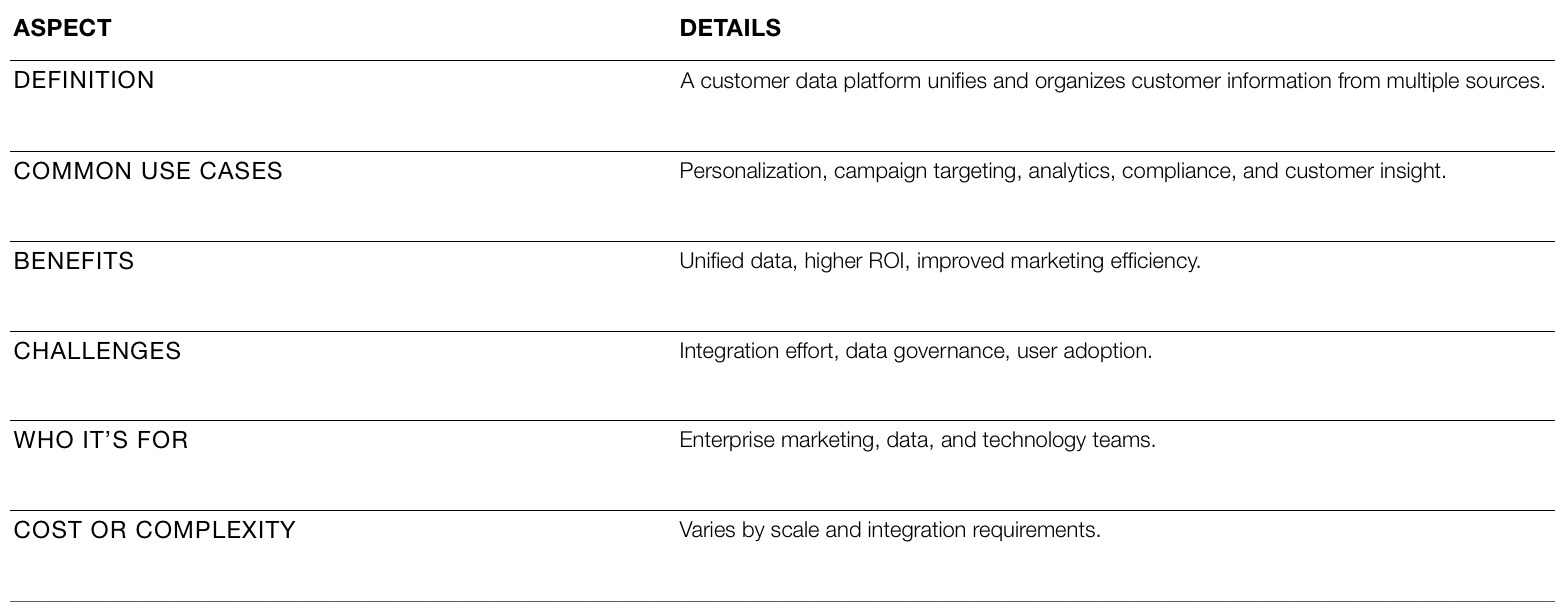
Customer Data Platform FAQs | What Is a CDP & How It Works
Introduction
Enterprise brands today are flooded with customer information across channels. Marketing teams struggle to unify data, personalize experiences, and measure results. Many leaders recognize that disconnected data limits business growth and decision-making.
This article explains what a Customer Data Platform (CDP) is, how it works, and why it matters for large organizations. It will clarify how CDP software centralizes customer information and turns it into actionable insights. Directors, SVPs, and Heads leading enterprise brands will understand what a customer data platform does, its key features, and its measurable benefits.
Market Context: Disruption & Opportunity
Customer expectations continue to rise as personalization becomes the standard. Brands gather data from websites, apps, loyalty programs, and CRM tools but often fail to connect them. This fragmentation leads to missed revenue, wasted ad spend, and poor user experiences.
Customer Data Platforms solve this issue by creating a unified customer profile that can power smarter marketing and analytics. As privacy regulations increase and cookies disappear, first-party data becomes critical. A CDP helps companies control their data, improve compliance, and enhance engagement. The opportunity lies in turning disorganized data into a single source of truth that drives measurable growth.
FAQs Snapshot

What is a Customer Data Platform?
A customer data platform is software that collects, unifies, and organizes customer information from multiple sources. It creates a single, consistent customer profile used across marketing, analytics, and service systems. In short, it helps teams understand each customer more clearly and act with precision.
Why is a Customer Data Platform important for enterprise brands?
Enterprise companies handle large, disconnected datasets. A CDP connects these systems, offering a unified view of each customer. This improves targeting, campaign performance, and personalization. For large organizations, a customer data platform reduces waste, increases efficiency, and supports compliance.
How does a Customer Data Platform work?
A CDP gathers data from digital platforms, CRM systems, and offline sources. It matches identities, removes duplicates, and updates profiles in real time. The data then powers analytics, segmentation, and campaign tools. Customer data platform software allows teams to build dynamic audiences and deliver relevant messages based on accurate data.
What are common Customer Data Platform features?
Customer data platform features include data collection, unification, segmentation, and activation. Many platforms also provide consent management, predictive analytics, and API integrations. These capabilities help brands manage data and activate it across channels efficiently.
What are the benefits of a Customer Data Platform?
The main benefits of a customer data platform include better personalization, improved marketing ROI, and enhanced compliance. CDPs help brands understand customers, create relevant messaging, and measure success more accurately. They also reduce data silos and improve collaboration between marketing and technology teams.
How is a Customer Data Platform different from a Customer Data Management Platform?
A customer data management platform focuses on anonymous audience data, often for advertising. A customer data platform focuses on known customer data across systems. The CDP builds individual profiles, while the customer data management platform organizes broader segments. Both are valuable but serve distinct roles in a brand’s data strategy.
Benefits of a Customer Data Platform
The benefits of a customer data platform extend across marketing, sales, and analytics. It allows enterprise brands to connect siloed data and build a unified customer profile. This helps teams improve decision-making and customer experiences.
Adopting customer data platform software helps reduce data duplication, improve targeting accuracy, and enhance personalization. With real-time access to unified data, marketers can automate workflows and measure engagement more effectively. For enterprise organizations, the benefits of a customer data platform also include stronger compliance, better collaboration, and improved return on investment.
Quick Summary Table

Let’s kickstart the conversation and design stuff people will love.

Deep-Dive Sections

What It Is & Why It Matters
A customer data platform is a centralized system that builds complete customer profiles using data from various channels. It solves the problem of data fragmentation common in large organizations. When data lives in silos, teams make decisions based on incomplete views. A CDP unifies this information, enabling consistent communication and insight-driven strategies. For enterprise leaders, adopting CDP software means more accurate analytics and better campaign performance.
How It Works
A CDP connects to data sources like websites, CRMs, apps, and offline systems. It ingests, cleans, and merges the data to create unified profiles. Advanced customer data platform features such as identity resolution and real-time updates ensure accuracy. The unified data is then shared with marketing tools for personalization and campaign execution. In short, the CDP acts as the foundation for a brand’s customer intelligence.
When to Use It (and When Not To)
A customer data platform is most effective when a company manages data from multiple systems or channels. It’s ideal for enterprises that want consistent personalization, cross-channel measurement, and improved compliance. However, smaller organizations with limited data complexity may not need one. In those cases, a simpler data management setup may be sufficient.
Tools or Platforms Involved
Customer data platform software integrates with CRMs, analytics platforms, and marketing automation tools. Leading providers include Salesforce, Adobe, and Segment. These systems allow data to move securely between sources, ensuring each department works from the same information. Selecting the right CDP depends on scale, existing systems, and technical readiness.
Cost Considerations
The cost of a customer data platform depends on data volume, features, and integrations. Enterprise-grade solutions often charge based on the number of profiles or data events processed. While initial setup can be resource-intensive, the return often outweighs the investment by improving marketing efficiency and customer retention.
Integration or Setup Requirements
Implementing a customer data platform requires technical alignment between IT and marketing teams. Integration involves connecting multiple systems, ensuring data quality, and setting governance rules. With the right partner, setup can be streamlined to minimize disruption and maximize impact.
Scalability & Flexibility
A well-implemented CDP can scale as data volumes and business needs grow. It allows teams to add new channels, regions, or products without restructuring their data systems. Scalability ensures that as customer interactions expand, insights remain accurate and actionable.
Pros and Cons
Pros: Unified data, improved personalization, better ROI, stronger compliance, real-time updates.
Cons: Initial setup effort, cost, and organizational change needed for adoption.
How G&Co. Can Help

G&Co. helps enterprise brands plan, integrate, and optimize customer data platform solutions. Our team brings strategic consulting and technical expertise to align CDP strategy with business goals. We understand what works, what doesn’t, and how to generate value quickly.
With experience across industries, G&Co. enables brands to unify data, streamline workflows, and improve performance. Talk to us to clarify your CDP strategy and move forward with confidence.
Conclusion & Next Steps
This guide explained what a customer data platform is, how it works, and why it’s critical for enterprise brands. With accurate, unified data, organizations can deliver stronger experiences, improve compliance, and increase marketing efficiency.
At G&Co., we’ve worked with enterprise clients to implement similar shifts—whether through digital strategy, customer journey redesign, or platform modernization. Our expertise helps brands translate knowledge into measurable advantage.
Still have questions? Reach out and let’s solve them together.






%20(1).png)





